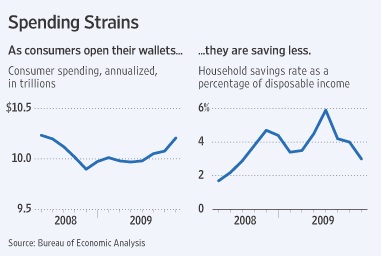With the holiday-shopping season approaching, many retailers, investors and politicians are hoping American consumers' animal spirits will return in force. They should be careful what they wish for.
Americans have good reason to be confused about what they should be doing to help the economy. On one hand, the Obama administration is crafting policies designed to make them save more and be more responsible about their finances. On the other, the same government is offering them incentives to spend, such as tax rebates and the "cash for clunkers" program.
Getty Images:
To a large extent, the mixed signals reflect a conflict between the stimulus the economy needs now and what's good for it in the longer term. As Mark Iwry, a senior adviser to Treasury Secretary Timothy Geithner puts it: "If you suffer a heart attack, your doctor's advice will probably include getting lots of regular exercise in the future -- but first you've got to get back on your feet."
In recent months, Americans have been recovering pretty well. In August, consumer spending logged its biggest one-month jump in nearly eight years, and last week many retailers reported better-than-expected sales for September. That helps bolster optimism among businesses, and it also benefits China, Germany and other major exporters, for which U.S. consumers are a crucial source of demand.
Journal Community:
• Discuss: Is the economy on the mend?
But there's a rub: Unless a resurgence in jobs or wages boosts people's income, any sustained rebound in spending will require them to cut back on savings at a time when they're still struggling with a massive debt burden. That, in turn, could revive the profligate pattern of U.S. borrowing from abroad that helped get the world in such trouble in the first place.
Economists have long fretted about the dangers inherent in the large gap between what the U.S. spends and what it earns. Known as the current-account deficit, the gap requires the U.S. to make ends meet by borrowing large amounts of money from abroad, typically from big exporters such as China. The flow of money encourages bubbles in financial markets, while the rising debts put downward pressure on the dollar.
U.S. policy makers recognize the need to close the gap. The administration of President Barack Obama has proposed expanding a tax credit for low-income savers, as well as a requirement that employers who don't offer 401(k) or similar programs automatically put a share of their workers' paychecks into individual retirement accounts. The Group of 20 developed nations has called for policies that would stimulate consumer spending in places such as China, while encouraging more saving in big consumers like the U.S.

So far, though, nothing has been implemented. As a result, if U.S. consumers return to their borrow-and-spend ways, they could easily reverse a trend that has seen the imbalances shrink in recent months. That would be particularly dangerous now, as the U.S. government's vast budget deficit is already adding to jitters about the dollar.
"We are more vulnerable, which of course means the world is more vulnerable, too," says Catherine Mann, a professor at Brandeis University's International Business School who specializes in international trade and finance. A devaluation of the U.S. currency, for example, would not only hit the massive dollar-denominated investments of China and other exporters but make their products less competitive in their most important export market.
The recent evidence on the direction of U.S. household saving and the current-account deficit is mixed. After peaking at 5.9% of disposable income in May, the U.S. household-savings rate fell to 3% in August -- well above the 0.8% low hit in April 2008 but not enough to make a big dent in household debt, which stood at about 125% of disposable income as of June. The U.S. current-account deficit shrank to 2.8% of gross domestic product in the second quarter from a peak of 6.5% in late 2005. But in a sign that it could be expanding again, the U.S. trade deficit was widening in the third quarter, the latest data suggest.
Some economists believe American consumers will be able to save and spend at the same time, buoyed by a new wave of hiring as companies gear up for a recovery. Stephen Stanley, chief U.S. economist at Royal Bank of Scotland, estimates that American consumer spending will grow an inflation-adjusted 3% in 2010, while the savings rate will rise as high as 6% and unemployment will fall to about 9%, from 9.8% as of September.
If, however, hiring proves as slow as it has been in the two previous U.S. recoveries, there will be little income growth to support consumer spending. Many economists see a bleak job outlook, together with tight credit, as reason to believe the recent rise in spending will prove short-lived. In one sign that borrowing isn't getting any easier, the Federal Reserve reported last week that U.S. consumers' outstanding credit dropped for the seventh straight month in August.
In many ways, a period of meager growth as people hunker down and put their finances back into order would be the best possible outcome -- particularly if businesses use the savings to make the kinds of investments that would boost their productivity and make the economy stronger in the future. Putting off the pain will only make it worse.